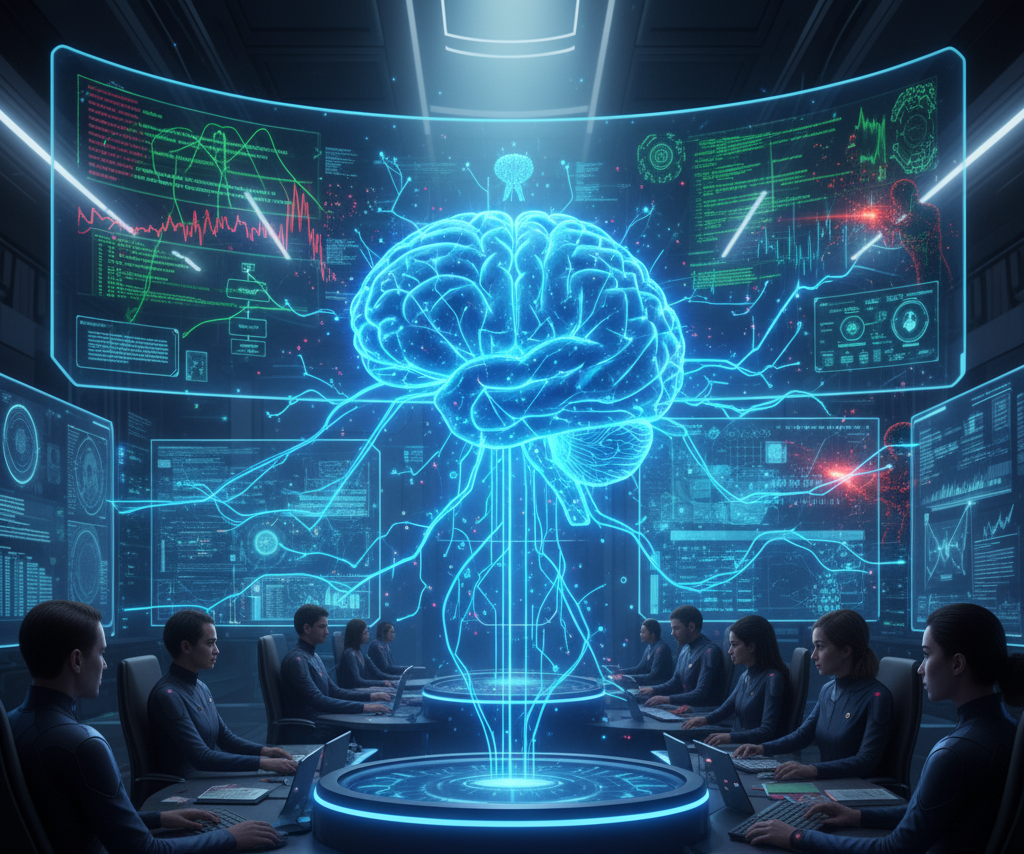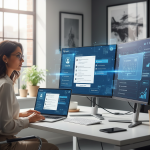Introduction: The New Face of Cybersecurity
Cybersecurity in 2025: How AI Is Fighting Hackers has become one of the most urgent topics in technology today. As digital threats grow more advanced, organizations can no longer rely on traditional defenses like firewalls and antivirus software. Hackers are using artificial intelligence to design smarter attacks, making it nearly impossible for outdated systems to keep up.
That’s why AI is now at the center of cybersecurity. From predictive threat detection to automated responses, artificial intelligence is helping businesses, governments, and individuals stay one step ahead. Unlike human-only security teams, AI works around the clock, analyzing massive amounts of data in real time to spot suspicious patterns before damage occurs.
In this article, we’ll explore how AI is transforming the cybersecurity landscape in 2025. We’ll look at the ways it detects threats, responds instantly, and helps industries fight back against increasingly sophisticated hackers.
That’s where artificial intelligence steps in as a game-changer for cybersecurity. Instead of reacting to threats after damage occurs, AI-powered systems predict, detect, and neutralize cyber risks in real time. The combination of machine learning, big data, and automation allows organizations to defend themselves faster and smarter. In 2025, cybersecurity has become a battle of algorithms, with AI on both sides of the equation: hackers using it to exploit weaknesses, and defenders leveraging it to fight back.
AI Cybersecurity 2025 is no longer just a concept it’s the reality shaping how businesses, governments, and individuals protect themselves online. In today’s hyperconnected world, hackers are smarter, faster, and increasingly using artificial intelligence to launch sophisticated attacks. Traditional firewalls and antivirus tools are not enough.If you prefer shorter SEO-friendly phrases like AI Cybersecurity 2025, that’s better for Google but may still fail the SEO plugin checklist since it wants exact match.
AI as the First Line of Defense
Smarter Threat Detection
Traditional security systems rely on rule-based detection, which means they only catch known threats. AI transforms this approach by analyzing massive amounts of data in real time, identifying unusual patterns, and flagging suspicious behavior before an attack occurs. For instance, if an employee’s account suddenly starts downloading huge volumes of sensitive files at odd hours, AI systems recognize this anomaly and instantly alert security teams.
In 2025, this proactive detection is standard practice. Security companies use deep learning algorithms trained on millions of attack samples to recognize malware variants, phishing attempts, and even subtle insider threats. Unlike humans, AI doesn’t get tired or distracted; it works around the clock, scanning every digital corner for vulnerabilities.
Automated Response Systems
Speed is everything in cybersecurity. Hackers can infiltrate a network and steal valuable data in minutes. AI-driven automated response systems drastically reduce reaction times by immediately isolating infected devices, blocking malicious IP addresses, or revoking suspicious login attempts. This automation doesn’t just save time; it prevents small breaches from turning into catastrophic data leaks.
Large enterprises and governments are increasingly adopting these systems to secure sensitive information. For smaller businesses, cloud-based AI security tools make enterprise-grade protection affordable, democratizing cybersecurity for everyone.

AI vs. AI: The Battle with Hackers
Hackers Using AI
The very technology that strengthens security is also a weapon for cybercriminals. Hackers now deploy AI to automate phishing campaigns, create deepfake identities, and develop malware that adapts to its environment. In 2025, AI-powered attacks are more deceptive and harder to detect than ever. For example, hackers use natural language processing (NLP) to generate convincing scam emails that mimic the writing style of real colleagues or CEOs.
Defensive Countermeasures
In response, cybersecurity teams have embraced AI not just for detection but for prediction. Predictive analytics allows systems to forecast likely attack scenarios based on hacker behavior and historical data. If attackers typically probe banking systems during specific hours or exploit certain software flaws, AI tools can anticipate and prepare defenses in advance.
This battle has become a high-tech chess game, with each side adapting rapidly. While hackers experiment with generative AI to create sophisticated threats, defenders are building more resilient networks that learn and evolve with every attack attempt.
Real-World Impact Across Industries
Finance and Banking
Financial institutions face constant cyber threats, from fraudulent transactions to ransomware. AI-powered fraud detection systems now monitor transactions in real time, comparing each activity against millions of legitimate and illegitimate patterns. When something looks suspicious, the system freezes the transaction before money changes hands. In 2025, this has significantly reduced online fraud cases, saving billions globally.
Healthcare
Healthcare systems, which handle sensitive patient data, are top targets for hackers. AI helps hospitals detect breaches quickly and secure electronic medical records. Beyond data protection, AI also monitors connected medical devices, ensuring hackers can’t tamper with equipment like insulin pumps or heart monitors. This blend of cybersecurity and patient safety highlights AI’s life-saving potential.
Small Businesses
Cybersecurity used to be a luxury for large corporations, but not anymore. Cloud-based AI tools have given small businesses access to affordable protection. Automated systems now handle threat detection, patch management, and email filtering, allowing owners to focus on growth instead of cyber risks. For many startups, this levels the playing field against larger competitors.
Challenges and Ethical Concerns
Bias and False Positives
While AI is powerful, it isn’t flawless. Algorithms sometimes misinterpret harmless activity as malicious, leading to false alarms. Too many false positives can overwhelm IT teams and erode trust in the system. Developers are working to refine AI models, but this remains a challenge in 2025.
Privacy Concerns
AI-powered security tools analyze vast amounts of personal and business data. This raises questions about privacy and data ownership. Who gets access to the data used to train these models? How do organizations balance protection with individual privacy rights? Striking this balance is critical to maintaining trust.
Dependence on AI
There’s also the risk of overreliance. As organizations lean heavily on AI, hackers may exploit weaknesses in these very systems. A single overlooked vulnerability in an AI model could compromise an entire network. Experts emphasize that AI should complement, not replace, human expertise in cybersecurity.
Conclusion
Cybersecurity in 2025 is no longer just about firewalls and passwords. It has evolved into a dynamic battlefield where artificial intelligence plays a central role. AI detects anomalies, predicts attacks, and responds in real time, making it a vital ally for businesses, governments, and individuals. At the same time, hackers are using the same technology to create smarter, faster, and more convincing threats.
The future of cybersecurity will depend on how well organizations balance AI innovation with ethical responsibility and human oversight. Companies must invest in AI-powered solutions while continuing to train employees, strengthen policies, and adopt a layered defense strategy. For individuals, awareness and digital hygiene remain crucial; AI can’t protect us from clicking suspicious links or using weak passwords.
In this new era, cybersecurity is a shared responsibility. With AI leading the charge, the digital world in 2025 has the potential to be safer, smarter, and more resilient against evolving threats.Explore global remote jobs on Wiraa, the #1 free platform for remote, and flexible jobs in development, marketing, writing, design, and many other fields.
AI Cybersecurity 2025: How Artificial Intelligence Is Hackers
Explore AI Cybersecurity 2025 and discover how it is reshaping cybersecurity by detecting threats, , and protecting industries worldwide.
Default for Posts (Web Page)Web PageItem PageAbout PageFAQ PageQA PageProfile PageContact PageMedical Web PageCollection PageCheckout PageReal Estate ListingSearch Results PageDefault for Posts (Article)ArticleBlog PostSocial Media PostingNews ArticleAdvertiser Content ArticleSatirical ArticleScholarly ArticleTech ArticleReportNone




